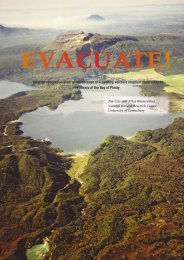Volcanoes - Ministry of Civil Defence and Emergency Management
Volcanoes - Ministry of Civil Defence and Emergency Management
Volcanoes - Ministry of Civil Defence and Emergency Management
Create successful ePaper yourself
Turn your PDF publications into a flip-book with our unique Google optimized e-Paper software.
main crater in 1914, forming a debris avalanche which<br />
killed 11 sulphur miners. All subsequent events have<br />
been small explosive eruptions, linked to the formation<br />
<strong>of</strong> collapse craters through the 1914 deposits. Since 1976,<br />
White Isl<strong>and</strong> has erupted low-silica <strong>and</strong>esitic magma,<br />
whereas most earlier activity involved higher-silica<br />
<strong>and</strong>esite or dacite. For many years, a plume <strong>of</strong> acidic<br />
steam has risen from fumaroles on the isl<strong>and</strong>, even during<br />
periods when the volcano was not actively erupting.<br />
However, from March-April 2003 onwards a lake has<br />
formed in the vent area, drowning the fumaroles.<br />
Submarine volcanoes <strong>and</strong> the Kermadec Isl<strong>and</strong>s<br />
Many large volcanoes occur along a northnortheast-trending<br />
line from the North Isl<strong>and</strong> linking<br />
with <strong>and</strong> including Tonga. Nearly all <strong>of</strong> these volcanoes<br />
are submerged beneath hundreds to thous<strong>and</strong>s <strong>of</strong><br />
metres <strong>of</strong> water, but the Kermadec Isl<strong>and</strong>s are where<br />
some <strong>of</strong> these volcanoes have constructed cones above<br />
the surface <strong>of</strong> the sea (Fig. 1). Work is still continuing<br />
to discover just how many volcanoes there are in this<br />
line, <strong>and</strong> little is known about their eruptive histories.<br />
The three major volcanoes in the Kermadecs (Raoul,<br />
Macauley <strong>and</strong> Curtis) <strong>and</strong> others <strong>of</strong> the largest cones are<br />
similar in size to Ruapehu.<br />
Although these volcanoes are broadly coneshaped<br />
like their mainl<strong>and</strong> counterparts, they differ<br />
in two respects. Firstly they have erupted substantial<br />
amounts <strong>of</strong> both dacite <strong>and</strong> basalt, rather than being<br />
dominated by <strong>and</strong>esite. Secondly the main processes<br />
causing destruction <strong>of</strong> the cones are marine erosion <strong>and</strong><br />
caldera collapse, the latter accompanying the most silicarich<br />
(dacite) eruptions. Unlike in the mainl<strong>and</strong> caldera<br />
volcanoes however, the caldera collapse only truncates<br />
the top <strong>of</strong> the cone, rather than engulfing it entirely.<br />
Raoul Isl<strong>and</strong> in the Kermadecs has experienced several<br />
historic eruptions, the most recent in 1964, <strong>and</strong> other<br />
volcanoes show strong fumarolic activity, indicative <strong>of</strong><br />
magma at shallow depths. The size range <strong>of</strong> eruptions<br />
in the <strong>of</strong>fshore volcanoes is greater than that usually<br />
considered the norm for cone volcanoes, <strong>and</strong> pyroclastic<br />
deposits (including ignimbrites) are prominent features<br />
<strong>of</strong> the young eruptive records.<br />
CALDERA VOLCANOES<br />
Taupo<br />
Taupo is a large caldera volcano, whose shape<br />
reflects collapse following two large eruptions about<br />
26,500 <strong>and</strong> 1,800 years ago, although the volcano itself<br />
first starting erupting about 300,000 years ago. The<br />
modern Lake Taupo partly infills this caldera structure.<br />
Taupo has erupted mostly rhyolite, with only minor<br />
amounts <strong>of</strong> basalt, <strong>and</strong>esite <strong>and</strong> dacite, <strong>and</strong> is the most<br />
frequently active <strong>and</strong> productive rhyolite caldera in the<br />
world. The eruptions are notable for varying enormously<br />
in size, from

















